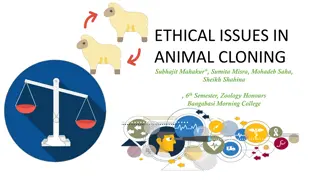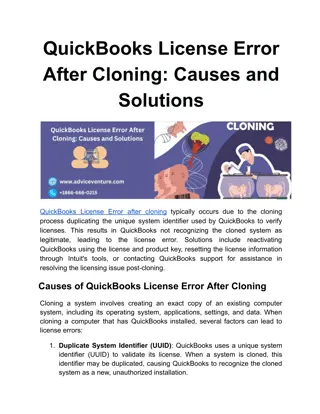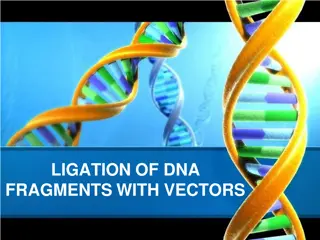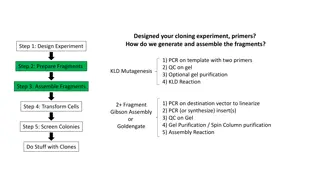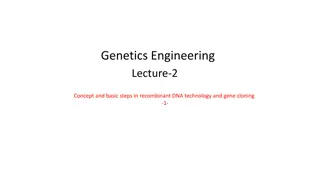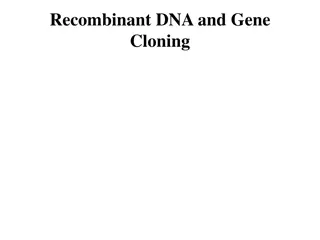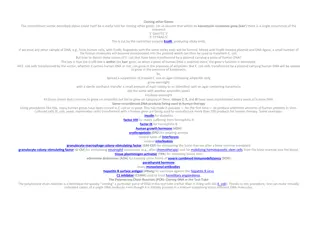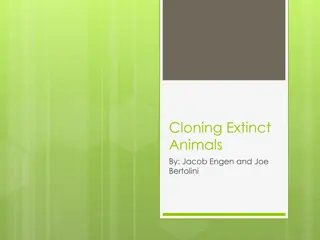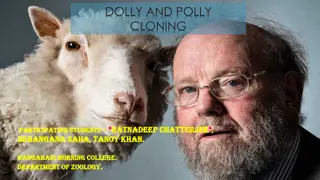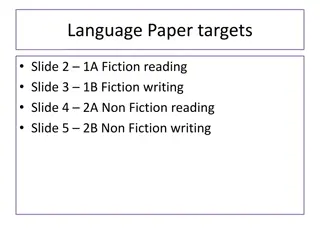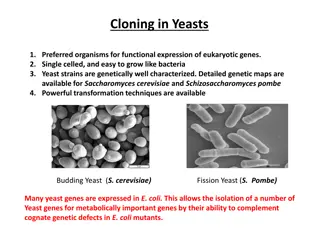
Cloning: Science Fiction or Science Fact?
Explore the world of cloning to extend knowledge on asexual and sexual reproduction. Discover how animals can be cloned and delve into the challenges associated with cloning. Learn about the concept of clones, asexual reproduction in various organisms like hydra, amoeba, bacteria, and plants, as well as sexual reproduction in plants. Gain insights into why sexual reproduction gives variation while cloning mammals does not.
Download Presentation

Please find below an Image/Link to download the presentation.
The content on the website is provided AS IS for your information and personal use only. It may not be sold, licensed, or shared on other websites without obtaining consent from the author. If you encounter any issues during the download, it is possible that the publisher has removed the file from their server.
You are allowed to download the files provided on this website for personal or commercial use, subject to the condition that they are used lawfully. All files are the property of their respective owners.
The content on the website is provided AS IS for your information and personal use only. It may not be sold, licensed, or shared on other websites without obtaining consent from the author.
E N D
Presentation Transcript
Cloning Science Fiction or Science Fact?
What we will do today Extend knowledge on asexual reproduction and sexual reproduction Learn how can animals be cloned Look at problems with cloning
What are clones? Genetically Identical copies
Asexual Reproduction Tiny 'buds' grow out from the hydra's side, develop mouth tentacles, and finally nip off at the base to form a separate individual.
Bacteria dividing asexually These are CLONES as only have information from 1 parent
Spider plant making asexual clones Plants retain some unspecialized cells These cells have the potential to grow into a whole new plant
Strawberry plants making asexual clones Whole new plants grow at the end of the runners How is this Possible?
Sexual reproduction Information (genes) from 2 parents in the sperm and egg
Sexual Reproduction in Plants Pollen carries genes from the male part of plants this fertilizes the ovule (female sex cell) POLLEN ovary containing OVULE
Cloning mammals Sexual reproduction produces variation not clones. Why?
Identical Twins Sperm fertilizes egg Fertilized egg starts to divide into a embryo, but the cells separate and each cell becomes a baby
Clones can be made naturally Identical twins are clones of each other Sperm cell Baby fertilisation splits Fertilised egg cell Baby Egg cell
Twin Welsh Lambs Clones of each other but not of their parents
Recently cloned animals Idaho Gem Cloned kitten
Dolly The Sheep Hello Dolly Hello Dolly Dolly was the first mammal cloned from an adult cell. She was born in 1996 and died in 2003. She was 6 when she died, about half the usual age for a sheep
Problems with cloning mammals Dolly developed premature arthritis and showed signs of aging too quickly She died 6 years old which is half the natural age of a sheep She is now owned by the National Museum in Scotland
Reproduction and Cloning Recap 1. Are Sonny and Cher clones? Explain your answer. 2. If I wanted to clone Sonny how would I do it? 3. What problems may I encounter if I try to clone Sonny.
Next lesson Uses of cloning Should we clone mammals? Will we clone humans? What would this mean?
This powerpoint was kindly donated to www.worldofteaching.com http://www.worldofteaching.com is home to over a thousand powerpoints submitted by teachers. This is a completely free site and requires no registration. Please visit and I hope it will help in your teaching.



